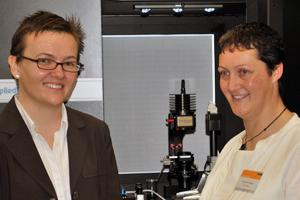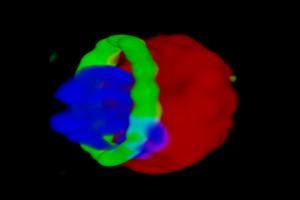The malaria parasite is giving up its blood cell invasion strategies to Australian scientists, with cutting-edge imaging technology at UTS giving the most detailed look ever at the way the parasite works.
Researchers from the Walter and Eliza Hall Institute working with Associate Professor Cynthia Whitchurch and Dr Lynne Turnbull from the ithree institute at UTS are claiming a first – the ability to capture high-resolution images of the parasite at each and every stage of invasion.

Associate Professor Cynthia Whitchurch
and Dr Lynne Turnbull

The Plasmodium falciparum malaria parasite
mid-invasion, visualised using the
OMX 3D-Sim Super-Resolution microscope
The findings, published this week in the journal Cell Host & Microbe, provide new insights into the molecular and cellular events that drive cell invasion and may pave the way for developing new treatments for malaria.
The work has been led by Dr Jake Baum, David Riglar and Dr Dave Richard from the Walter and Eliza Hall Institute along with colleagues from the institute's Infection and Immunity division.
Dr Baum said the real breakthrough for the research team had been the detail revealed by UTS's DeltaVision OMX 3D-Sim Super-Resolution microscope, one of only two in the world.
"Whilst we have observed this miniature parasite drive its way into the cell before, the beauty of the new imaging technology is that it provides a quantum leap in the amount of detail we can see, revealing key molecular and cellular events required for each stage of the invasion process," Dr Baum said.
"This technology enables us to look at individual proteins that we always knew were involved in invasion, but we never knew what they did or where they were, and that, we believe, is a real leap for malaria researchers worldwide."
Associate Professor Whitchurch said the results were, "just the beginning of an exciting new era of discoveries enabled by this technology that will lead to a better understanding of how microbes such as malaria, bacteria and viruses cause infectious disease."
Malaria is caused by the Plasmodium parasite, which is transmitted by the bite of infected mosquitoes. Each year more than 400 million people contract malaria and as many as a million, mostly children, die.
The work was supported by the National Health and Medical Research Council, The University of Melbourne, Canadian Institutes of Health, UTS and the Australian Research Council.

